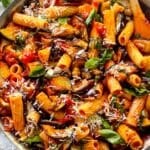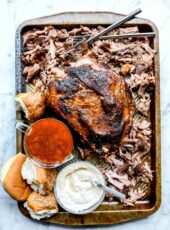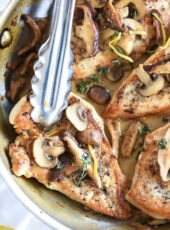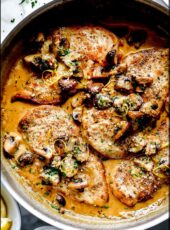Pasta alla Norma (eggplant pasta) is a classic, vegetarian Sicilian pasta dish with loads of flavor. I make it with my easy homemade marinara sauce with sweet-roasted eggplant for the best texture and flavor.
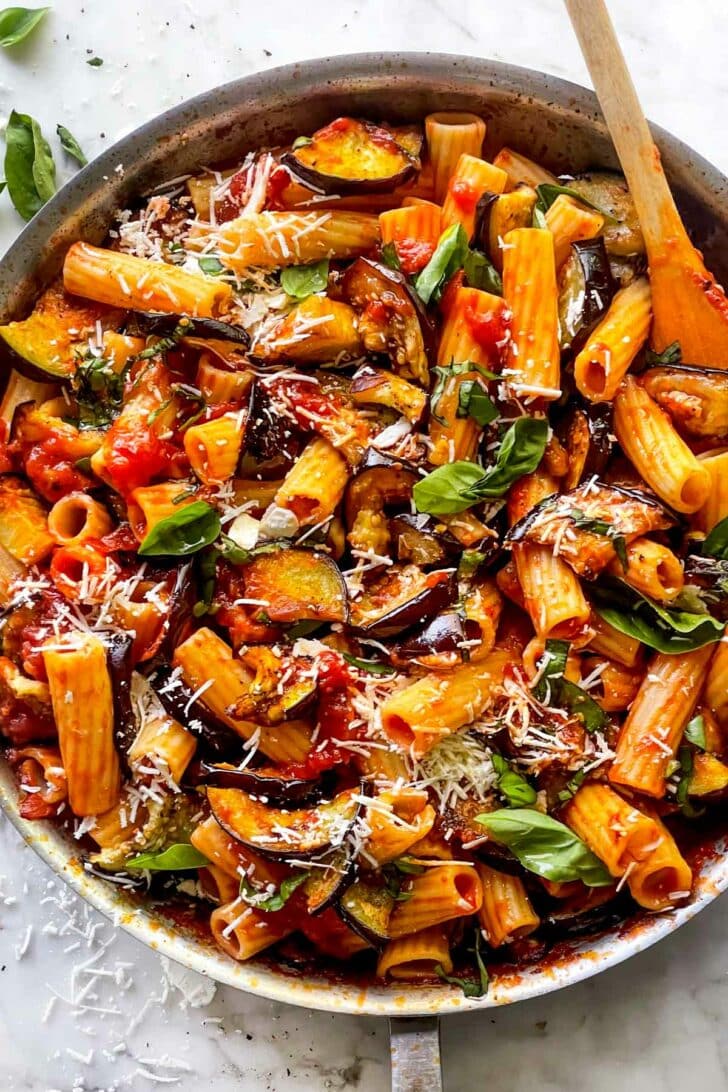
Pasta alla Norma is one of those iconic Italian dishes that if I ever see on a restaurant’s menu, I must order. Just like chicken Parmesan, puttanesca, cacio e pepe, and chicken piccata, I was inspired to find the best way to make it at home. Pasta alla Norma is a Sicilian dish, featuring pasta cloaked in a robust tomato sauce with fried or roasted eggplant, plenty of fresh basil, and topped with freshly grated ricotta salata. It’s the perfect thing to make when eggplants are in season and fresh basil is still plentiful. It’s vegetarian, but hearty, and tastes like late summer.
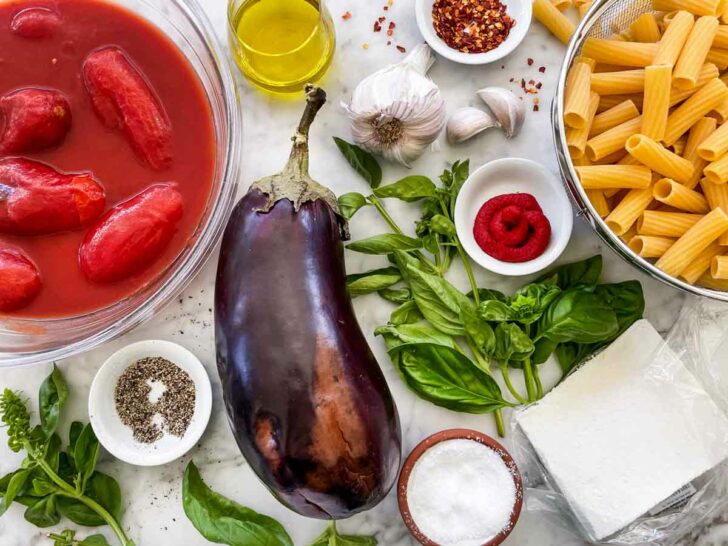
In This Post
What’s in Pasta alla Norma (Eggplant Pasta)
At first glance, it may seem like there are quite a few ingredients in this pasta alla Norma, but it’s actually pretty straightforward and made mostly with pantry staples. Here’s what you’ll need to make it:
For the marinara sauce:
- Canned whole peeled San Marzano tomatoes in their juice
- Extra-virgin olive oil
- Garlic
- Tomato paste
- Kosher salt and freshly ground black pepper
- Fresh basil or oregano
- Eggplant (I like the globe variety best for this, which is what you typically will see at most grocery stores).
- Kosher salt
- Extra-virgin olive oil
- Rigatoni or other short pasta or even gnocchi
- Red pepper flakes (optional, but I like the subtle kick they lend)
- Fresh basil
- Marinara sauce (I love my homemade marinara recipe for this, but you can always use a high-quality jarred sauce.)
- Ricotta salata (if you can’t find ricotta salata, you can use pecorino or cotija), and while it’s not tangy sheep’s milk cheese, torn fresh mozzarella that melts into the in this.
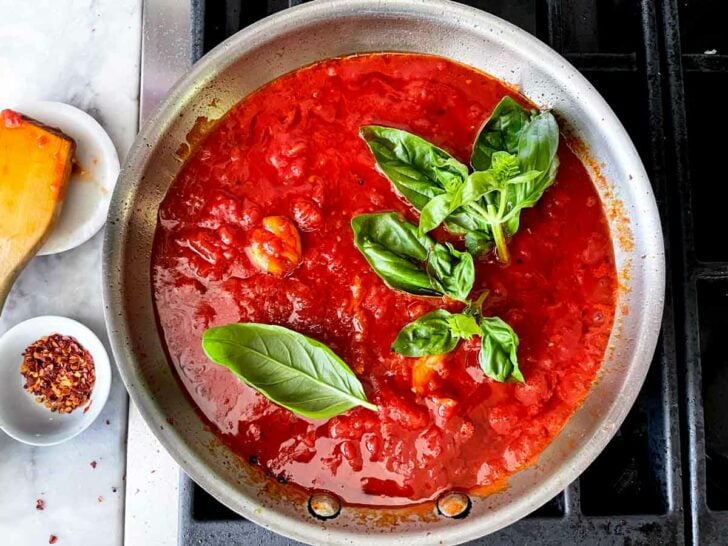
How to Make Pasta alla Norma
Pasta alla Norma is an easy dish to make. Start your sauce then roast your eggplant while it simmers and thickens (two birds, one stone). It comes together quickly, too. Here’s how to make it:
Make the Marinara Sauce
Crush the tomatoes. Pour the tomatoes and purée into a bowl and crush with your hands or the back of a spoon, then set aside.
Bloom the garlic. In a large cold skillet, add the extra-virgin olive oil and garlic cloves, and bring to medium heat. As the garlic begins to sizzle, stir occasionally, and cook until fragrant and golden, about 5 minutes. Monitor the heat so the garlic doesn’t cook too quickly or burn. Add the red pepper flakes when the garlic is golden so they don’t burn and turn acrid.
Toast the tomato paste. Remove the skillet from the heat and very carefully stir the tomato paste into the garlic and oil—be extra mindful so the oil doesn’t splatter and burn you as the paste is added—and cook for 1-2 minutes.
Simmer, reduce, and thicken. Spoon the tomatoes into the pan with the oil and tomato paste then season with salt and pepper. Add the basil and bring to a boil. Reduce to a bubbling simmer, stirring occasionally, for 30 minutes. Stir to mix the oil that rises to the top, then discard the basil sprigs and garlic.
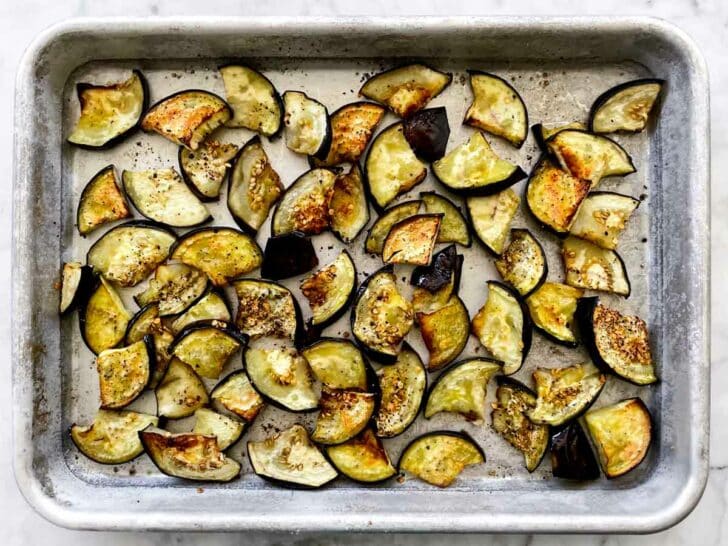
Roast the Eggplant
The biggest question mark for me when developing this recipe (other than to salt or not salt the eggplant prior to cooking—more on that below), was how to cook the eggplant. Traditional recipes have you fry it in a generous pool of olive oil, while some, more recent iterations opt for roasting. I tried my hand at both methods and found that my eggplant had a better, firmer texture after roasting, with some nice caramelization and sweetness that roasting provides. I also like that there’s no turning or babysitting required, and it’s healthier since roasting only employs a fraction of the olive oil. Just make sure you don’t overdo it and end up with eggplant chips!
Slice the eggplant. Preheat your oven to 425°F. Cut the ends off the eggplants. Slice them in half, vertically, then cut them into ½-inch (half-moon) shaped pieces.
Season and roast. Brush a large sheet pan with olive oil and arrange the eggplant pieces in an even layer. If needed, divide the eggplant between two sheet pans. Brush the eggplant tops with olive oil, sprinkle with kosher salt, and place in the oven to roast until golden brown.
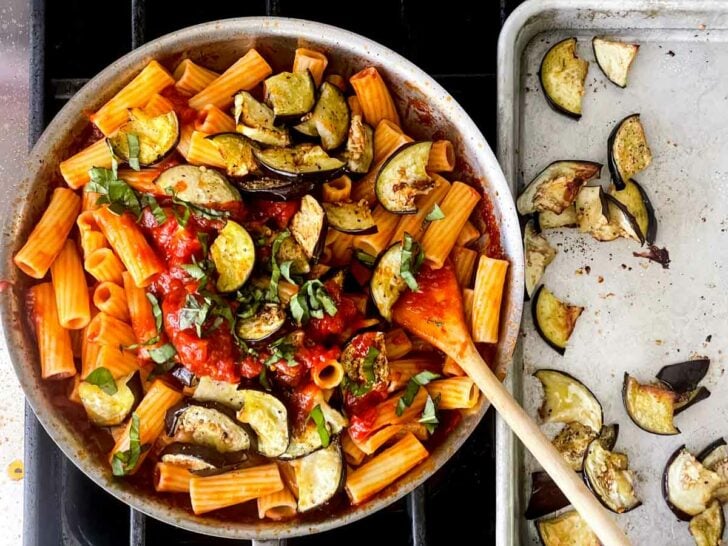
Do You Need to Salt Your Eggplant?
There’s long been a debate about salting and draining eggplant before cooking. Some people say salting helps draw out any bitterness. I think it’s more about helping eliminate some of the excess moisture. Salting your eggplant is definitely not mandatory, and for roasting it’s really not necessary. If you were frying or sautéeng your eggplant, I’d advise it, but here you can skip the salt.
What is Ricotta Salata
Ricotta salata is an Italian sheep’s milk cheese. Unlike ricotta, it has a firm, dry texture and a sharp, salty bite. It’s an important element in pasta alla Norma, but it’s not always easy to find. If needed, substitute pecorino romano, cotija, or even feta cheese. Or, you could do what I like and tear up some fresh buffalo mozzarella then let it melt into the sauce like in my gnocchi pomodoro. It doesn’t have the same bite as ricotta salata, but I can’t resist its rich creaminess.
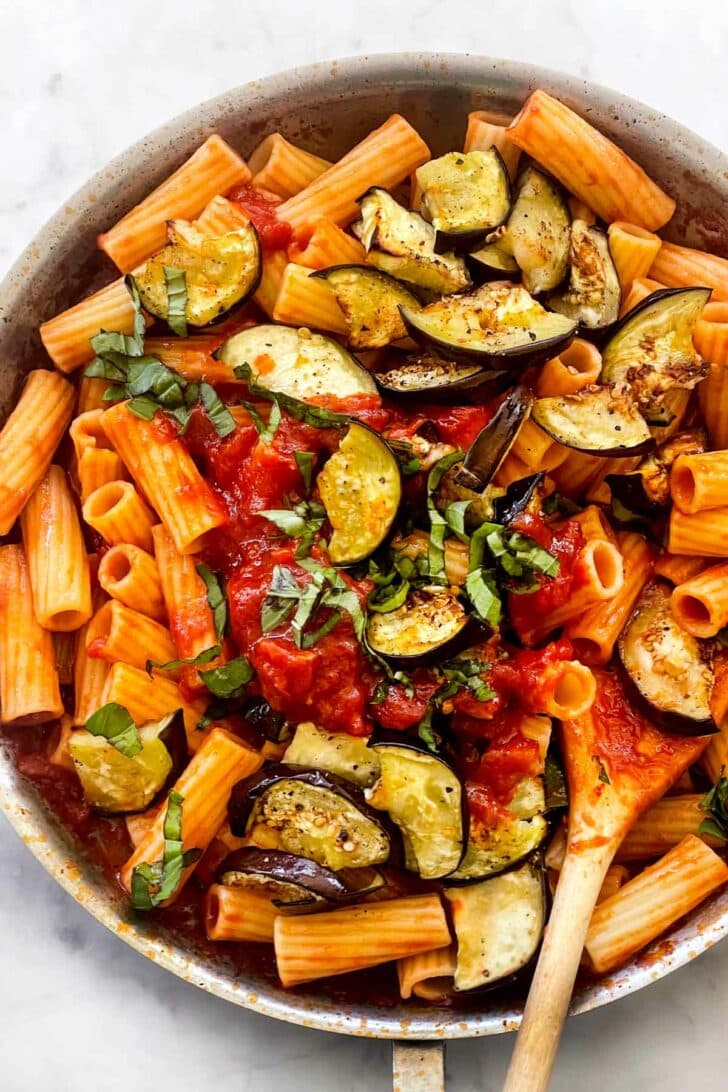
Where Does Pasta alla Norma Come From
Pasta alla Norma comes from Catania—a town in the Sicilian region of Italy.
What is the Meaning of Pasta alla Norma
It’s said that the name “pasta alla norma” came from the Italian writer Nino Martoglio, who, upon trying the dish proclaimed it a real “norma” (“masterpiece,” in Italian, and a nod to the Italian opera “Chista è ’na vera Norma!”).
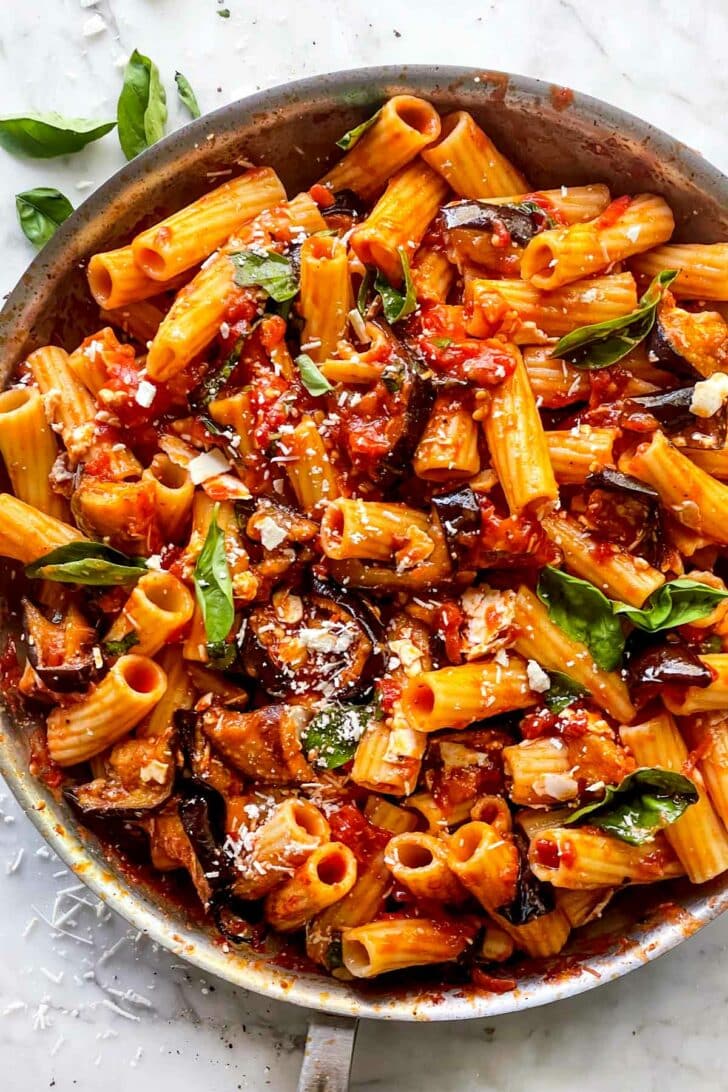
Pasta alla Norma (Eggplant Pasta)
Ingredients
- For the marinara sauce:
- 1 28- ounce can whole peeled San Marzano tomatoes with purée
- ¼ cup extra-virgin olive oil
- 4 garlic cloves peeled and smashed
- ¼ teaspoon red pepper flakes
- 1 tablespoon tomato paste
- 1 teaspoon kosher salt
- ½ teaspoon freshly ground black pepper
- 2 sprigs fresh basil
- For the pasta:
- 2 ½ pounds globe eggplant
- kosher salt
- extra-virgin olive oil
- 1 pound rigatoni
- ¼ teaspoon kosher salt
- ½ cup torn basil leaves plus more for serving
- 2 cups easy homemade marinara sauce or you can use jarred
- Ricotta salata (or pecorino or cotija if you can’t find it)
Instructions
- For the Marinara Sauce:
- Pour the tomatoes and purée into a bowl and crush with your hands or the back of a spoon, then set aside.
- Add the extra-virgin olive oil and garlic cloves in a large skillet, and bring to medium heat. As the garlic begins to sizzle, stir occasionally, and cook until fragrant and golden, about 5 minutes. Monitor the heat so the garlic doesn’t cook too quickly or burn. Add the red pepper flakes and cook for another 30 seconds.
- Remove the skillet from the heat and let the oil cool slightly. Carefully stir the tomato paste into the garlic and oil. Be EXTRA mindful so the oil doesn’t splatter and burn you as the paste is added—and cook for 1-2 minutes. Spoon the tomatoes into the pan with the oil and paste and season with salt and pepper. Add the basil sprigs and bring to a boil. Reduce to a bubbling simmer over low heat, stirring occasionally, for 30 minutes. Stir to mix the oil that rises to the top, then discard the basil sprigs and garlic. Remove sauce from heat.
- For the Pasta:
- While the sauce is simmering, roast your eggplant. Preheat your oven to 425°F. Cut the ends off the eggplants. Slice them in half, vertically, then cut them into ½-inch (half-moon) shaped pieces. Brush a sheet pan with olive oil and arrange the eggplant pieces in an even layer. Use two sheet pans if needed. Brush the eggplant tops with olive oil, sprinkle with kosher salt, and place in the oven to roast until golden brown, for about 30 minutes or so.
- While the eggplant roasts, fill a large pot with water and bring to a boil. Once boiling, salt the water generously. Add the pasta and cook until al dente. Use a mug or Pyrex to reserve ¾ cup of the pasta water. Drain, then add the pasta, basil, marinara, and roasted eggplant to the large pot you cooked the pasta in. Gradually stir in the pasta water (start with ½ cup, then add more if needed) and stir well to combine. Taste and add more salt or red pepper flakes if desired. Transfer the pasta to a serving bowl and top with freshly grated ricotta salata and more basil.
